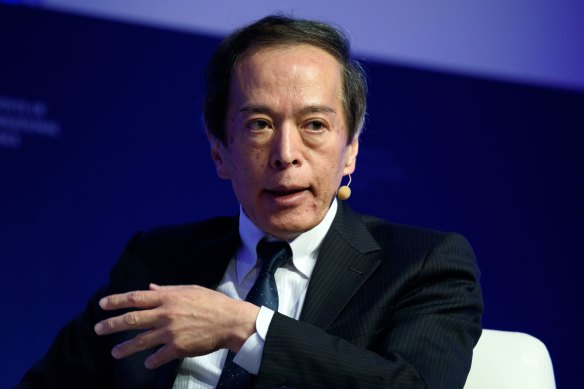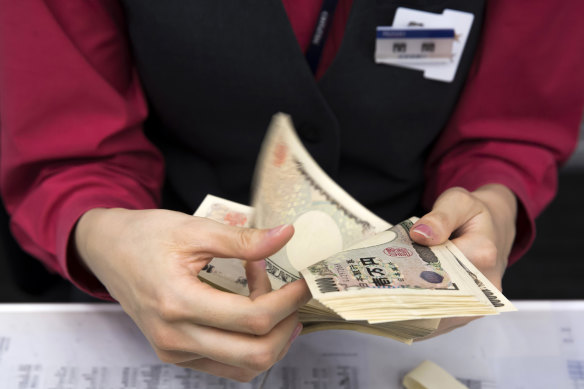Opinion
The world is watching Japan very closely
Stephen Bartholomeusz
Senior business columnistThe Bank of Japan surprised everyone last Friday when it changed the settings of its long-standing yield curve control policy, tightening monetary policy and sending ripples of unease through global currency and bond markets.
Japan’s 10-year bond yield spiked to its highest level in almost a decade after the Bank of Japan said that its 0.5 per cent cap on the bonds’ yields was no longer a “rigid limit” but would now be a “reference”. The bank’s relatively new governor, Kazuo Ueda, said the bank would not tolerate a 10-year yield above the new ceiling of one per cent and would “step in” with bond buying if it did.

Bank of Japan chief Kazuo Ueda shook up markets last week.Credit: Bloomberg
While it’s not quite the abandonment of Japan’s seven-year-long yield curve control policy, the change is another step towards its end.
By setting caps on government bond yields and defending those caps with billions of dollars of purchases (to the point where the Bank of Japan owns more than half of all the bonds on issue), the bank was hoping to extricate Japan’s economy from decades of stagnation.
Unlike most of the world, which has been raising interest rates to try to kill off unpalatably high levels of inflation, Japan has been trying to kindle inflationary growth.
It is on the verge of success, with the economy growing solidly, if unspectacularly, this year and posting an inflation rate of 3.3 per cent in June.
There is an expectation within financial markets that the policy will be abandoned before the end of this year.
Traders created an initial crack in the yield curve policy last December when bond traders forced the yields on bond issues around the key 10-year issue beyond the then ceiling of zero per cent, plus or minus 25 basis points, and caused the bank to raise the cap to 0.5 per cent.
Governor Ueda, however, was anxious to talk down that prospect, saying the changes were aimed at improving the sustainability of the framework and describing the new one per cent ceiling on ten-year yields as a “just in case” cap.
The bank has kept its overnight rate at minus 0.1 per cent – among the world’s major central banks, the only remaining negative rate – saying it needed more time to sustainably achieve its two per cent inflation target.

The Japanese economy has been growing solidly this year.Credit: Getty Images
Ueda has previously suggested that much of the increased inflation Japan has been experiencing is essentially transitory, driven by the residual effects of the pandemic and by the impact of the war in Ukraine on energy and food prices. He wants to see sustained wages growth before contemplating the normalisation of monetary policies.
What the Bank of Japan does matters to the rest of the world, hence the volatility in other financial markets generated by the unexpected change in the policy. Bond yields in the US and Australia, for instance, rose in response to the announcement and the yen appreciated, briefly, against most of the other major currencies.
Japan’s unconventional monetary policies since its property bubble burst in the early 1990s have helped make it the world’s largest creditor nation, exporting capital in search of the higher interest rates and returns elsewhere. It has net international investments of more than $US3 trillion ($4.49t), about a third of them in the US but also major holdings in Europe and Australia.
As it has modestly raised the caps on its yields, and the markets have become convinced that the yield curve control measures will be abandoned, there has recently been a modest reversal of the longer-term depreciation of the yen against other major currencies, a trend that had sharpened this year as the US Federal Reserve Board, European Central Bank and other central banks, like the Reserve Bank, have kept raising their policy rates.
That small shift in the long-term trend has suggested some repatriation of Japanese funds held offshore, a trickle that could turn into a flood if Japan’s monetary policies were normalised and the markets were left free to set yields.
Equally, had the Bank of Japan not tinkered with the policy on Friday, there was a risk that the interest rate differentials with the other major economy – the Fed raised its funds rate for the 11th time in 17 months last week – would have kept sinking the yen amid a further exodus of capital and added to the rising costs of energy and food imports.
Normalisation would impact not just bond yields elsewhere, which would rise if there were a diminished Japanese presence, but other asset classes like shares and property.
While those markets wobbled briefly on Friday before stabilising, there’d have been significantly more volatility if Ueda had announced the abandonment of the yield curve controls.

As it has modestly raised the caps on its yields, and the markets have become convinced that the yield curve control measures will be abandoned, there has recently been a modest reversal of the longer-term depreciation of the yen against other major currencies,Credit: Bloomberg
A fully-fledged reversal of capital flows as capital flowed back to Japan would be akin to a tightening of monetary policy in all the economies where Japan is a major investor.
It could also trigger some financial stresses.
Since it began its then-experimental unconventional policies back in the 1990s, borrowing cheaply in yen to invest in higher-yielding assets elsewhere – usually in highly-leveraged trades – has been the preferred carry trade of the world’s hedge funds. In the past year, with the yen depreciating heavily, it has been used to fund deals in everything from US bonds to South American currencies.
Were Ueda to abandon yield curve control and the yen to strengthen significantly and quickly, those trading strategies might instantly be transformed from profitable to loss-making trades. As it is, the latest cautious step on the path to policy normalisation probably makes those trades less profitable and riskier.
There is an expectation within financial markets that the policy will be abandoned before the end of this year.
With Ueda essentially claiming that the Bank of Japan isn’t backing out of its policies and that the changes are more technical than substantive – the bank says its target for long-term rates is still around zero per cent – Friday’s developments have caused some confusion among market participants.
That may have been deliberate, if Ueda wants to keep the markets guessing and foreign traders wary about trying to force the bank into their preferred path.
At some point, however, if the stirrings of wages growth now being seen in Japan do flow through into real gains and core inflation remains solidly positive, he will have no choice but to outline how the bank plans to extricate itself from the yield curve control policy without igniting shocks, not just within its own markets, but throughout the global financial system.
The Market Recap newsletter is a wrap of the day’s trading. Get it each weekday afternoon.